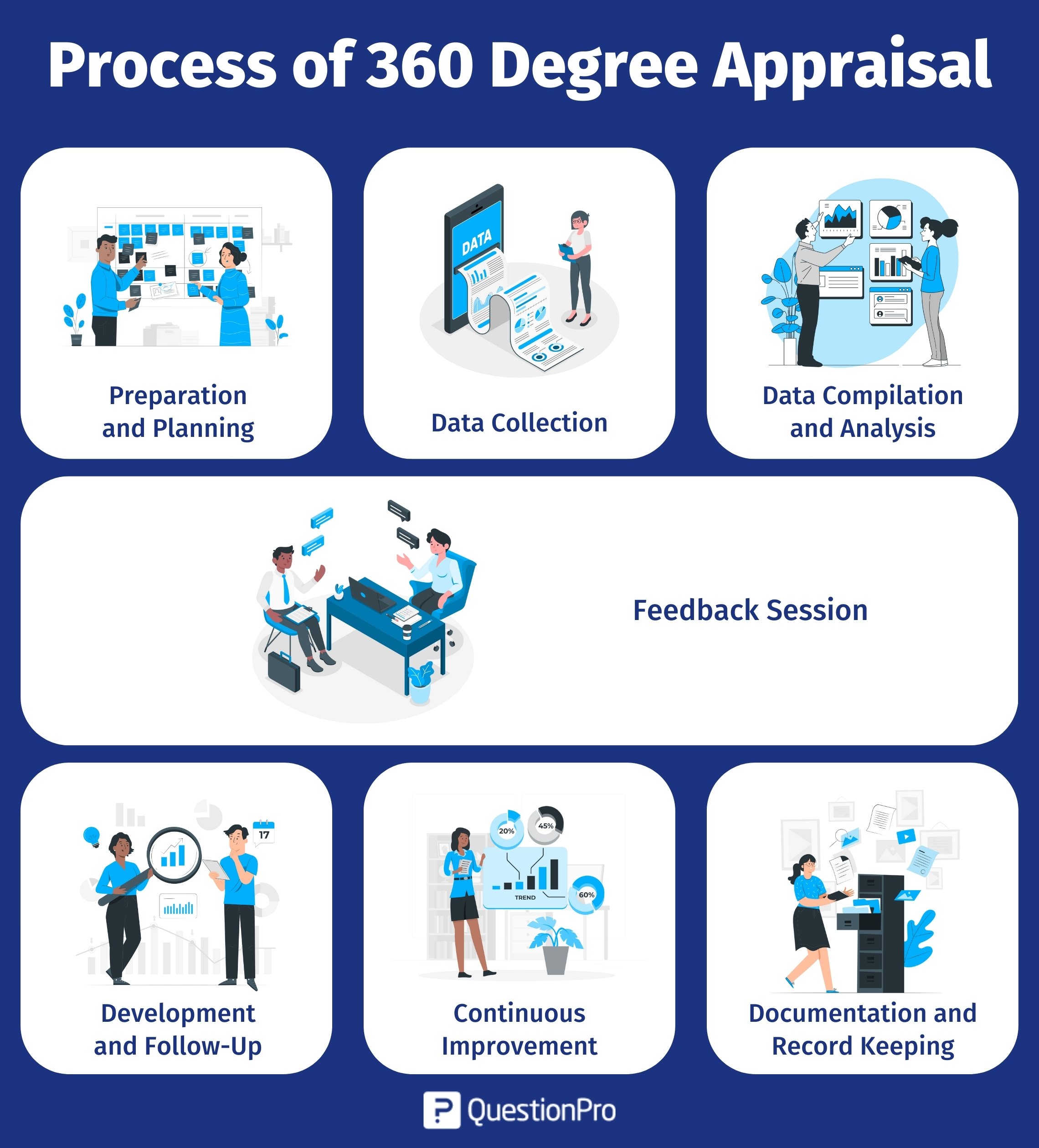
In the world of performance appraisal and evaluation, the traditional top-down approach is gradually giving way to more holistic and comprehensive methods. One such method that has recently gained popularity is the 360 degree appraisal.
This evaluation approach is designed to provide a complete and well-rounded assessment of an individual’s performance by gathering feedback from various sources within and outside the organization.
In this blog, we will delve into the concept of 360 degree appraisal, its benefits, and how it can contribute to a more comprehensive evaluation process.
What is 360 degree appraisal?
360 degree appraisal, also referred to as a 360 degree feedback system or multi-rater feedback, is a comprehensive performance evaluation process that gathers frequent feedback from multiple sources.
Key Components of 360 Degree Appraisal
- Self-Assessment: The employee evaluates themselves, providing insight into their own perception of their strengths and weaknesses.
- Manager Assessment: Supervisors or managers provide feedback based on their observations of the employee’s performance review.
- Peer Assessment: Colleagues or coworkers assess the employee’s performance, offering a perspective from those who work closely with them.
- Subordinate Assessment (if applicable): In cases where the employee manages others, direct reports can offer feedback on their leadership and managerial skills.
- External Stakeholder Assessment: Clients, customers, or external partners may also provide feedback, offering an external perspective.
Importance of 360 Degree Appraisal
The importance of 360-degree appraisal, or multisource receiving feedback or assessment, cannot be overstated in today’s dynamic and competitive work environment. This performance evaluation approach plays a vital role in talent management and organizational development for several key reasons:
Holistic Performance Assessment
360 degree appraisal provides a well-rounded and holistic view of an individual’s performance. Traditional top-down evaluations by supervisors often lack the complete picture, as they may not have direct exposure to all aspects of an employee’s work.
This method offers a more comprehensive understanding of an individual’s contributions and behavior by gathering performance feedback from various sources, such as supervisors, peers, subordinates, and even clients.
Increased Self-Awareness
Self-awareness is a fundamental component of personal and professional growth. 360 degree employee feedback helps individuals gain insights into how their actions, behaviors, and performance are perceived by others.
This newfound self-awareness can be a catalyst for positive change and development as individuals identify areas for self-improvement.
Targeted Development
The feedback surveys collected through 360 degree appraisals are specific and actionable. It highlights strengths and weaknesses in an individual’s performance and behavior.
This information is invaluable for setting clear goals and developing targeted strategies for improvement. It allows individuals to focus their efforts on areas that will significantly impact and improve performance and career progression.
Enhanced Communication and Collaboration
360 degree feedback promotes better communication and collaboration within teams and across the organization by involving multiple stakeholders in the appraisal process.
It encourages open and constructive dialogue, improving working relationships and increasing team cohesion.
Reduced Bias and Subjectivity
Traditional performance appraisals often suffer from conscious and unconscious biases that can affect the fairness and accuracy of evaluations.
360 degree appraisals help mitigate these biases by aggregating honest feedback from multiple sources. This reduces the risk of one person’s opinion or perspective disproportionately influencing the evaluation.
Alignment with Organizational Goals
When designed and implemented effectively, 360 degree appraisals can be tailored to align with an organization’s strategic objectives.
This ensures that the appraisal process focuses on the competencies and behaviors that are most critical for the organization’s success.
Employee Engagement and Motivation
Involving employees in the evaluation process and valuing their input can boost engagement and motivation.
When employees feel that their voices are heard, and their feedback is taken seriously, they are more likely to be committed to their roles and the organization.
Continuous Improvement
360 degree feedback is not a one-time event but an ongoing process. Regular feedback and follow-up assessments allow individuals to track their progress over time and make necessary adjustments.
This commitment to continuous improvement aligns with the principles of a learning organization.
Learn About: 360 Feedback Forms
Process of 360 Degree Appraisal
Conducting a 360 degree appraisal involves several key steps to ensure that the collected feedback is comprehensive, objective, and valuable for personal and professional development.
Here is a typical process for implementing a 360 degree appraisal:

01. Preparation and Planning:
- Identify Purpose and Goals: Clearly define the purpose of the appraisal and the specific goals you aim to achieve. Determine what competencies and behaviors will be assessed.
- Select Participants: Identify the individuals who will provide feedback. This typically includes supervisors, peers, subordinates, and sometimes external stakeholders like clients or customers.
- Choose a Tool: Select or design a 360 degree feedback tool or questionnaire that aligns with the appraisal’s objectives. Ensure that the questions are clear, relevant, and appropriate for the participants.
- Ensure Anonymity: Assure participants that their feedback will remain confidential, which encourages honesty and openness in their responses.
- Training: Provide training to participants, both those providing feedback (appraisers) and those receiving feedback (the individual being appraised). Training should cover the purpose of the appraisal, how to complete the feedback forms and the importance of providing constructive feedback.
02. Data Collection:
- Distribution of Questionnaires: Distribute the questionnaires to all participants, ensuring they understand the completion process and timeline.
- Data Collection Period: Set a specific timeframe for participants to complete the questionnaires. This could range from a few weeks to a month, depending on the size of the organization and the number of participants.
- Anonymous Feedback: Emphasize the importance of anonymity in the feedback process. Participants should return their completed questionnaires directly to a designated neutral party or system to maintain confidentiality.
- Reminder Communications: Send reminders to participants as the deadline approaches to ensure a higher response rate.
03. Data Compilation and Analysis:
- Data Entry: Enter the collected feedback data into a secure database or software system, ensuring the anonymity of responses.
- Data Analysis: Analyze the feedback data to identify patterns, trends, and areas of strength and improvement. This may involve aggregating scores, categorizing comments, and creating summary reports.
04. Feedback Session:
- Feedback Review: Arrange a feedback session with the individual being appraised. Review the positive and negative feedback during this session, focusiing on strengths and improvement areas. Ensure that the feedback is provided in a constructive and supportive manner.
- Goal Setting: Collaboratively set specific goals and action plans based on the feedback received. These goals should be designed to address areas for improvement and capitalize on strengths.
05. Development and Follow-Up:
- Development Plan: Create a development plan that outlines the steps and strategies the individual will take to address the identified areas for improvement.
- Follow-Up Assessments: Implement a follow-up process to track progress and provide ongoing support. This may include additional 360 degree appraisals at regular intervals to assess development progress.
- Support and Resources: Ensure that individuals have access to the necessary resources, training, coaching, or mentoring to help them achieve their development goals.
06. Continuous Improvement:
- Evaluation of the Process: Periodically evaluate the effectiveness of the 360 degree appraisal process. Collect feedback from participants to identify areas for improvement in the process itself.
- Iterate and Adjust: Use feedback and lessons learned to refine the process for future rounds of appraisals, making it more effective and efficient.
07. Documentation and Record Keeping:
- Record Keeping: Maintain thorough records of all feedback, goals, action plans, and progress reports for each participant. This documentation can be valuable for performance management and organizational development.
Benefits of 360 Degree Appraisal
360 degree appraisal, also known as multi-rater or 360 degree feedback, offers numerous benefits to individuals and organizations. Here are some of the key advantages of using this comprehensive performance evaluation method:
Comprehensive Feedback
360 degree feedback provides a more holistic view of an employee’s performance, addressing blind spots and uncovering areas for improvement that may not be apparent in traditional appraisals.
Developmental Insights
It can be a powerful tool for personal and professional development as employees gain insights into their strengths and areas that need improvement.
Fairness and Objectivity
Including multiple perspectives reduces potential bias and offers a more balanced and objective assessment.
Team and Organizational Development
When used at the team or organizational level, 360 degree feedback can highlight collective strengths and areas for improvement, promoting overall growth.
How QuestionPro Workforce Can Help in 360 Degree Appraisal
QuestionPro Workforce offers valuable features and support for organizations looking to implement and benefit from 360-degree appraisal, a method that provides comprehensive feedback on an individual’s performance from multiple perspectives. Here’s how QuestionPro Workforce can assist in 360-degree appraisal:
Leadership Development
- QuestionPro focuses on helping leaders grow through feedback from all directions.
- Leaders throughout the organization have a key role in shaping the overall culture and engaging employees.
- By using feedback, leaders can aim for excellence and make positive contributions to the organization.
Customizable Technology
- QuestionPro Workforce provides customizable solutions for 360-degree measurement systems.
- Organizations can adjust the appraisal process to meet their specific needs.
Inclusive Focus
- The 360-degree feedback emphasizes inclusion, grit, capacity, and other relevant aspects.
- This approach ensures a wide range of leadership skills and qualities is considered, providing a holistic view of an individual’s performance.
Streamlined Process
- The platform aims to simplify the 360-degree feedback process, making it powerful and straightforward.
- It offers a user-friendly interface and easy-to-understand dashboards for simple data interpretation and quick insights.
Data-Driven Decision-Making
- The platform aligns with the broader goal of making organizations data-driven.
- By leveraging insights from 360-degree feedback, organizations can make informed decisions about leadership development initiatives, talent management, and overall organizational growth.
Real-Time Feedback
- Recognizing that employee needs and performance expectations are dynamic, QuestionPro Workforce emphasizes the importance of real-time feedback.
- This feature ensures that leaders have access to timely insights, enabling them to adapt and make positive impacts on the organization promptly.
Confidentiality and Anonymity
- The platform incorporates state-of-the-art demographic rosters to provide a high level of confidentiality.
- This ensures that feedback is gathered anonymously, promoting honesty and openness in the appraisal process.
Conclusion
360 degree appraisal offers a comprehensive and balanced approach to employee performance evaluation, promoting personal and professional growth. While it comes with challenges, it can be a valuable tool for organizations to improve individual and team performance when implemented effectively.
By fostering a culture of open communication, transparency, and continuous development, organizations can unlock the full potential of 360 degree appraisal to drive success and growth.
QuestionPro Workforce is a comprehensive solution for organizations seeking to implement and enhance 360-degree appraisals. The platform’s technology, customization options, emphasis on confidentiality, AI analysis, real-time insights, and expert support collectively contribute to a powerful tool for fostering leadership development and organizational growth.







